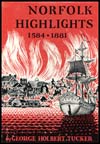Chapter 4
The Origin of Norfolk's Name
The name Norfolk as a corporate appellation was derived from the "Towne of Lower Norfolk County" ordered to be established by the Lower Norfolk County Court on August 18, 1680, in compliance with "An Act for Co-habitation and the Encouragement of Trade and Manufacture" passed in June of the same year by the General Assembly of Virginia in Jamestown.
The town's name was derived from Lower Norfolk County in which it was located and which then included the area now occupied by the cities of Norfolk, Portsmouth, Chesapeake, and Virginia Beach.
Lower Norfolk County was originally a part of Elizabeth City County, earlier known by "the savage name of Kiccowtan."
The first court for Lower Norfolk County, then designated as "the Lower County of New Norfolk," was held on May 15, 1637. And it is significant that Captain Adam Thorowgood (1604-1640, also spelled "Thoroughgood"), the man who according to long-standing tradition was responsible for naming the new county for his native shire of Norfolk in England, was the presiding justice.
Thorowgood, who was Lower Norfolk County's leading citizen in his day, also traditionally changed the name of the Chesopean River, on which he received a princely grant of 5,350 acres of land in 1635, to the Lynnhaven River in memory of the King's Lynn in his native Norfolk. It is said that Thorowgood changed the name because of the then striking resemblance between the Virginia river and the River Ouse that flows through the Norfolk fenland to the Wash and the North Sea.
Be that as it may, there is another theory as to how the name of Norfolk became a Virginia appellation. Briefly, the facts are these:
On July 5, 1636, King Charles I wrote to Governor John Harvey of Virginia on behalf of Henry, Lord Maltravers, ordering him to grant the latter a tract of land in the southern part of Virginia "as may beare the name of a county and be called the county of Norfolk."
Since Lord Maltravers belonged to the family that formerly bore the title of Duke of Norfolk, it is obvious where the proposed name for the new county came from.
As the king's letter miscarried, however, another letter was dispatched on April 11, 1637, repeating the request for the grant that was finally made by Harvey on January 22, 1637/38.*
Even the most casual examination of the date of the first sitting of the Lower Norfolk County Court (May 15, 1637), however, will show that the county had been established and named nine months before Harvey made the grant to Maltravers on January 22, 1637/38.
This more or less leads one to believe that the Thorowgood tradition is correct.
Another argument in its favor is the fact that Thorowgood was a member of the Governor's Council at the time of the establishment of Lower Norfolk County. And this, together with the fact that he was the leading citizen of the new territory, makes it highly probably that he was permitted to name the new county, from which the Norfolk of today takes its name, for his native shire in England.
That the transplanted captain from Norfolk, England, took his position seriously and was not lightly trifled with is evident from a record of the court for the new county that he traditionally named dated May 15, 1637.
This tells us that a certain woman with an overfree tongue who had been impertinent to Thorowgood was sentenced to receive twenty lashes on her bare back for her sauciness.
* Editor's Note: The 1637/1638 notation reflects the difference between the Old Style calendar and the New Style, which England did not adopt until 1752. In the Old Style, New Year's was marked on March 25. So, January 1637 in the Old Style would be what we think of as January 1638.
Chapter 5
The History of Norfolk's Site
Norfolk Highlights 1584 - 1881

See the "Table of Contents" for links to every chapter in Norfolk Highlights 1584 - 1881 by George Holbert Tucker.
